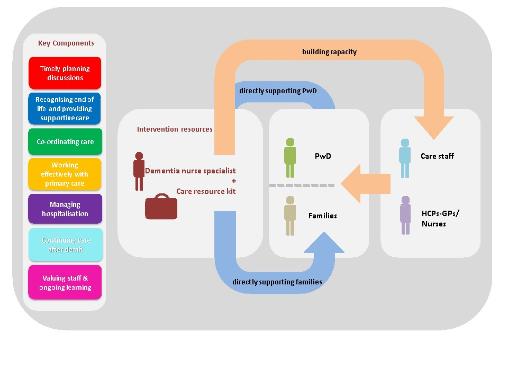Workstream 3

April 2017
Overview of the SEED intervention
The aim of the SEED intervention is to improve end of life care (EoLC) for people with dementia (PwD) and their families by:
- Developing capacity of existing health and social care professionals to deliver good EoLC to PwD and their families
- Activating and co-ordinating existing services
- Providing direct support to PwD and their families (if needed).
The intervention comprises (Figure above):
- A person - a Dementia Nurse Specialist
- Lists of tasks and otucomes relating to the seven key factors show to support the delivery of good EoLC in dementia
- A care resource kit comprising existing and newly developed resources.
Each of these components is described briefly below.
A Dementia Nurse Specialist
The Dementia Nurse Specialist will be based in primary care but will work with a range of community health and social care professionals who are involved in EoLC for PwD. A key focus of the intervention is on building capacity in existing services and improving linkages and co-ordination of existing resources. This will ensure that any changes made as a result of the intervention are sustainable. The Dementia Nurse Specialist may also provide some hands-on care to PwD and families if needed.
Seven key factors which support good end of life care in dementia
Our qualitative work has highlighted seven key factors which underpin the delivery of good EoLC for PwD. These seven key factors have informed the job description of the Dementia Nurse Specialist:
- Undertaking timely planning discussions to ensure plans are discussed when the PwD still has capacity and that they are approved, documented and disseminated. While PwD may be reluctant to engage in planning, evidence indicates that failing to do so can increase pressure on family members at already stressful times.
- Recognising end of life (EoL) and providing supportive care to ensure effective management of key symptoms (e.g. pain, anxiety and nausea), and minimising distress by providing comfort in a familiar environment.
- Co-ordinating care includes liaison between day and night staff in services and having established links with local hospices, particularly for support out of hours.
- Working effectively with primary care can be facilitated by having a named liaison person in the practice. For care homes liaison can be improved by scheduled routine visits and limiting the number of GP practices with which their residents are registered.
- Managing hospitalisation includes avoiding unnecessary admissions by appropriate out of hours support and documentation of wishes and preferences. It also involves managing admission and discharge effectively where hospitalisation is required.
- Continuing care after death can enable family members to be supported by known members of staff who were involved in providing EoLC for the person with dementia. This continuity of care is valued by family members.
- Valuing staff and ongoing learning facilitates staff retention and results in a more skilled and knowledgeable workforce. Stable staff teams are more able to detect signs of emotional vulnerability in their colleagues and ensure timely and appropriate support.
A care resource kit comprising existing and newly developed resources
The research team have identified and reviewed a wide range of resources relating to EoLC and the seven key factors, focusing on those specifically concerned with dementia where possible. Part of the role of the Dementia Nurse Specialist will be to identify any gaps where new resources may be required. The list of resources will evolve over the pilot trial as the Dementia Nurse Specialist, core intervention team and others identify new resources.
A potential new resource identified through the qualitative work is a care planning guide for PwD and their families; a paper version and an App version. These new resources are in the process of development and will continue to be developed iteratively throughout the pilot trial of the intervention.